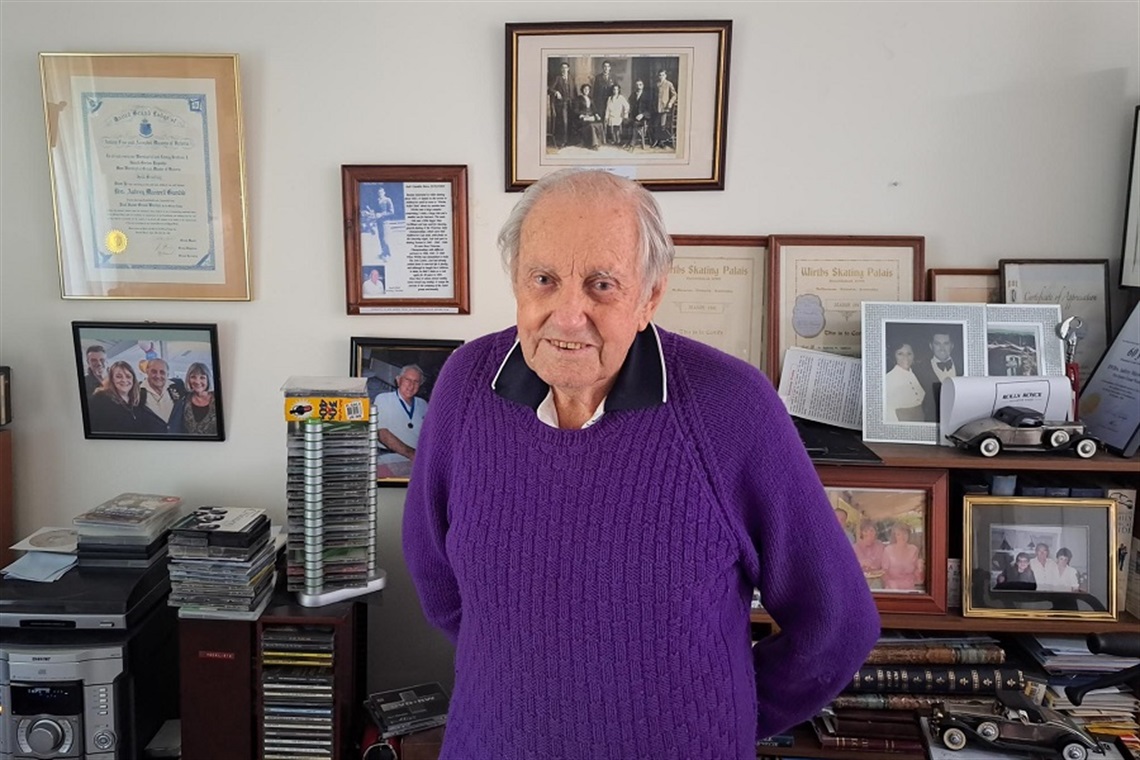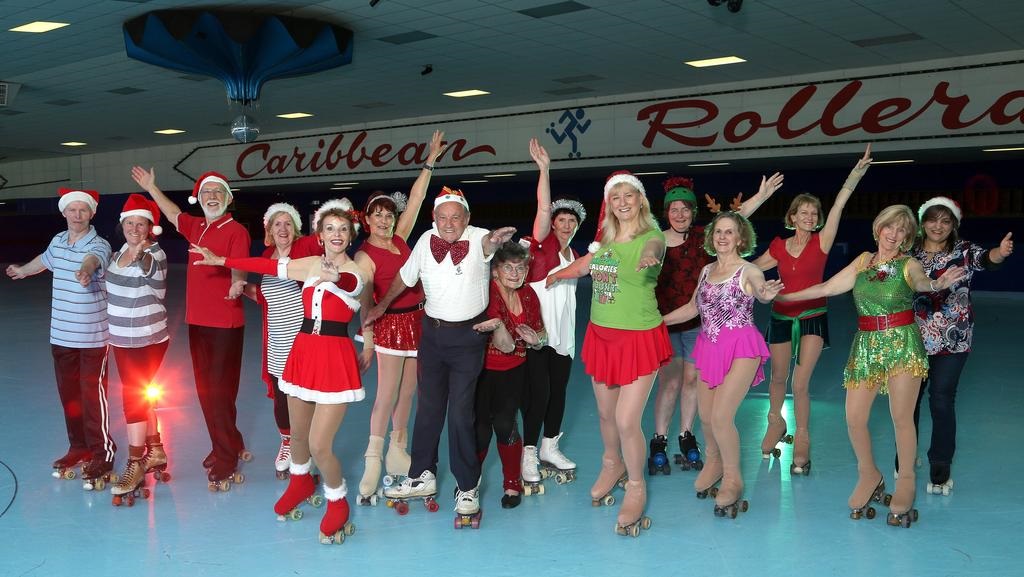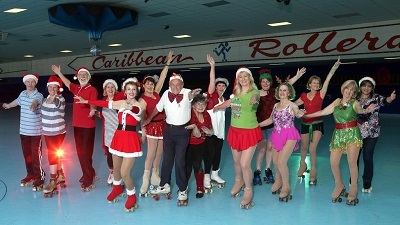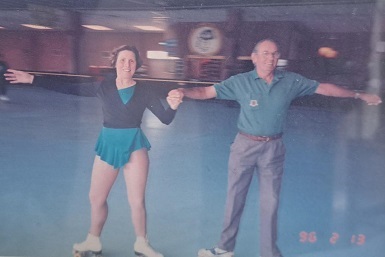Aubrey’s secret to living a long and healthy life
Published on 09 August 2023

It was quite by chance that Aubrey first discovered roller skating.
“I noticed my father had a pair of broken skates under the counter of his shop, and one day I just asked him, ‘Can I have a go with these?’”
Where those skates came from is still a mystery to Aubrey, as his father wasn’t a skater and never talked about skating. They were beat up and partially broken, but something about them appealed to a 16-year-old Aubrey, and with his father’s permission, he pulled them on and headed out to the street.
So began an all-consuming passion for roller skating that would last more than 85 years.
Aubrey was just 14 when, like many others during the Great Depression, he dropped out of school and went to work to earn a little bit of money for his family.
“I got 10 shillings a week, which is about $1, and worked a 60-hour week,” remembers Aubrey, whose first job was in his father’s hairdressing and tobacconist shop.
Roller skating, therefore, became a much-needed outlet where he could spend some time on his own in the fresh air and travel fast. Really fast.
“Skating is such an exhilarating thing. It provides such a sense of freedom. It’s a bit like the first time you drive a car,” says Aubrey.
 “I got that same sort of feeling on my motorbike. You can breeze along Beach Road on your motorbike on a sunny day, and it’s such a great sensation.”
“I got that same sort of feeling on my motorbike. You can breeze along Beach Road on your motorbike on a sunny day, and it’s such a great sensation.”
He began by skating on the streets by himself, learning the basics and experimenting with jumps, spins and different skating styles.
“[The great thing about skating is that] you can do it on your own and have a ball,” he says.
Aubrey notes that because one of the skates was broken, he first had to learn how to skate on one leg until he could figure out how to fix the faulty boot.

It wasn’t until a few years later, in the late 1930s, that Aubrey set foot – or rather, skate – on an actual skating rink, but as he points out, “if you’re used to skating on a road, when you do get on a rink, you just fly!”
The Wirths Roller Rink – which has since been demolished and replaced by the Arts Centre – became a second home to Aubrey, and it was there that he started to compete in skating competitions after mastering a number of highly technical dance moves. One such move was the “spread eagle”, which requires a skater to glide on both feet, with the toes turned out and the heels facing each other. For many, it can be a difficult position to learn, but not for Aubrey.
“I had no trouble doing the spread eagle. My legs must have been deformed or something,” he says with a laugh.
It was this natural ability that saw Aubrey become a three-time winner of the Victorian Skate Championships, in 1945, 1947 and 1949. Each competition he won with a different dancing partner and performing different routines, including one of his favourites, the cutaway waltz.
“It’s a beautiful waltz to watch,” says Aubrey. “It’s a difficult waltz to do, but I loved it.”
In 1949, Aubrey married his wife, Nelly, and hung up his skates. While raising six children together, other hobbies emerged for Aubrey, with golf being the main one, but his passion for skating lingered. Then, when Nelly passed in 1991, Aubrey decided to pull on his skates once again, at the age of 70.
For the next few decades, Aubrey was a regular at the Caribbean Rollerama in Scoresby, and despite having triple bypass surgery in his late 80s, he continued skating weekly right up until he was 96.
Now 101 years old, Aubrey keeps active through his volunteer work. He volunteered with Meals on Wheels in Moorabbin for 20 years, and still volunteers weekly at the OzChild op shop in Highett – a role that, much like his skating career, came about almost by accident.
“I walked into the op shop one day and saw a record player that wasn’t working,” says Aubrey, who offered to have a look at it. “As it turned out, the issue was something I could fix.”
When he took it back to the op shop, he noticed a few other things that were about to be thrown out. “So, I said, ‘I can take a look at these too if you like?’”
Just like that, a new chapter began for Aubrey. Now, every week he’ll bring home all sorts of faulty items – radiators, electric irons, you name it – and tinker with them at his home workshop, returning everything he manages to fix to be sold at the op shop. While he’ll have a go at fixing anything – his background as a textile engineer means he’s very handy with a toolbox – broken watches have become his signature item.
“The op shop would get watches donated that weren’t working, so I’d play around with them to see if I could fix them. Some of them just had a flat battery, so I started buying a range of batteries.” Now, a corner of his home is dedicated to his watch workshop, with trays upon trays of meticulously catalogued batteries of all shapes and sizes.
“I don’t have a lot of money, but what little money I do have I spend on batteries,” he laughs. It’s not always easy work and it can be quite fiddly dealing with all the small parts, but Aubrey loves the challenge.
“At my age, my hands are not bad. They’re not as good as they were, but they’re not bad. They haven’t got the wobbles. I still have a fair amount of control.” Aubrey laughs as he says this, but he’s completely right. At 101, Aubrey is astoundingly fit and healthy.
So, what is his secret to living a long and healthy life? He puts it very simply: don’t worry.
“I very coarsely say I don’t give a stuff about anything, and that’s quite true. Over the last 15 to 20 years, I’ve adopted that attitude. Got another bill? Bad luck.
“If you worry about things, you don’t sleep well at night. I sleep comparatively very well at night.”
Aubrey is also very passionate about continuing to live in his own home, and is fiercely protective of the freedoms he has by living independently.
“Living at home means you are free to do what you want, when you want to do it,” he says, noting he really enjoys playing songs by Irving Berlin and Al Bowlly throughout the day, as this is the music he used to dance to at the skating rink. “I love this little unit.”
Through the services he receives as an AccessCare client, Aubrey feels supported to continue living on his own.
“The support worker picks me up and takes me shopping, so I can pick the food I want to eat,” says Aubrey. “Mind you, I’m very easy to please with food! There are very few things I don’t like, but there’s a lot of food I like better than others.”
It’s easy to see why Aubrey is so content at home – the inside of his house is a joyful celebration of his long and impressive life. Photos of his family and ancestors line the walls, and his skating championships take pride of place on the mantle. Other treasures include a certificate congratulating him on the hole in one he scored on the eleventh hole at the Brighton Golf Club back in 1976, and the letter he received from Queen Elizabeth II two years ago on his 100th birthday.
There’s no denying Aubrey has a special connection with to his home, and AccessCare is delighted to support Aubrey to retain the lifestyle he loves.
“I watched the cricket until half past one the other night, which is something I couldn’t do [in a nursing home]. There are many things I wouldn’t be able to do that I would sorely miss,” Aubrey says. “So I’m very happy living here, and I try to keep it so by not worrying about a darn thing.
“I’ve got everything I want right here; why would I want to leave?”
Photos (from top of page to bottom):
1. The walls of Aubrey’s home are adorned with photos, certificates and memorabilia from a long life, well lived.
2. Aubrey celebrating his 95th birthday at the Caribbean Rollerama (image credit: Hamish Blair for the Knox Leader).
3. Aubrey demonstrating the difficult “spread eagle” move back in the 1970s.